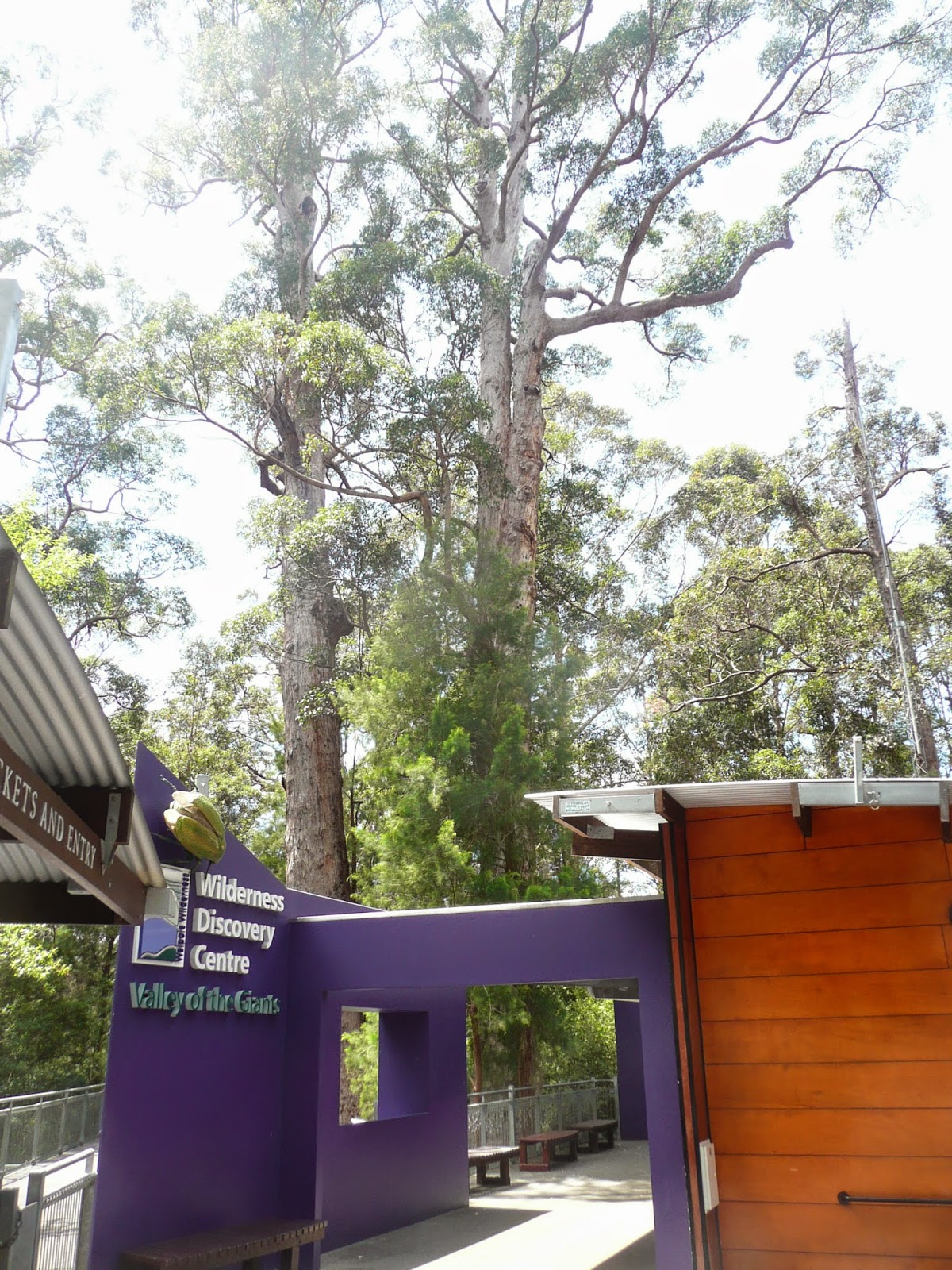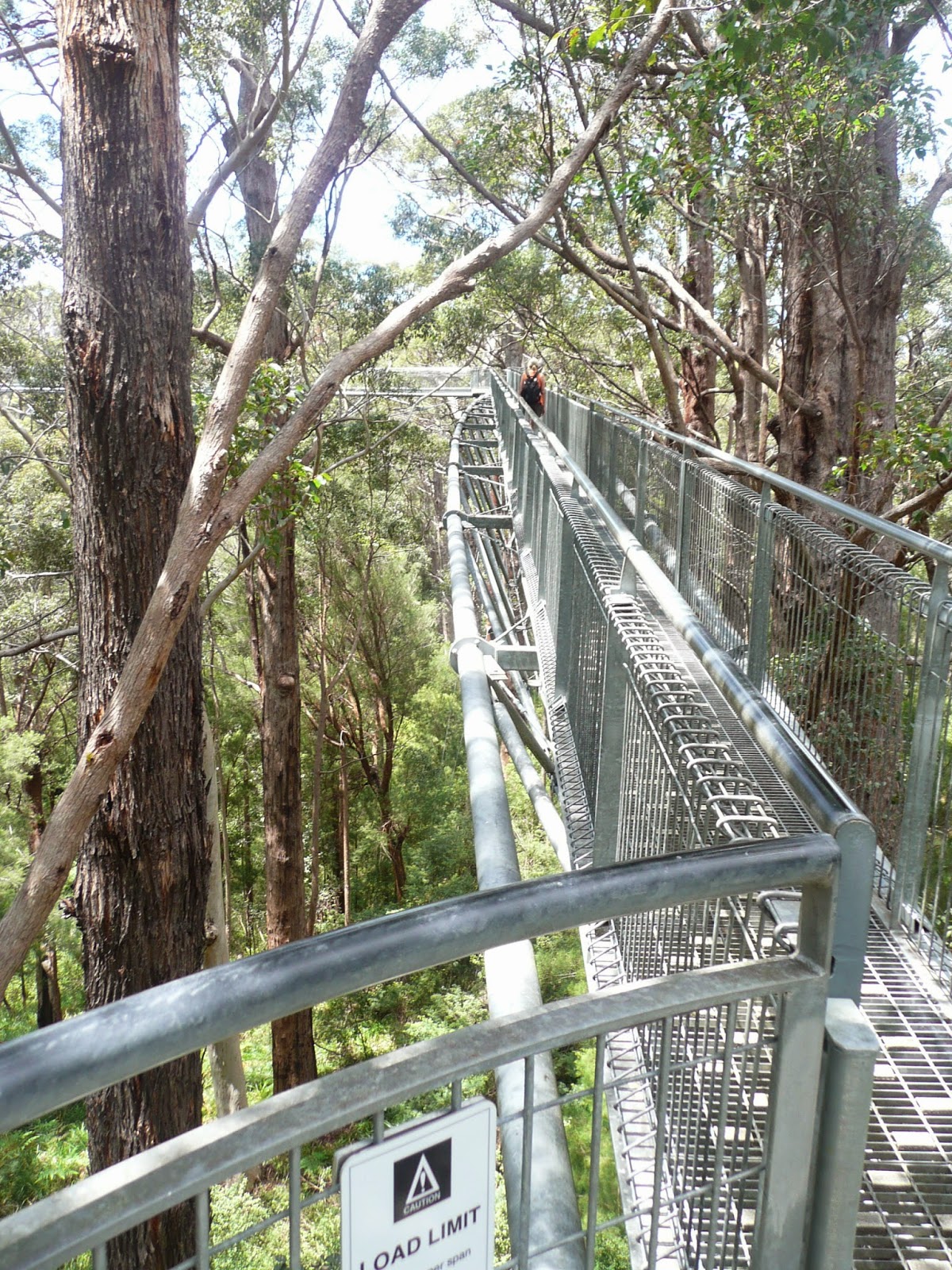We're getting there folks, slowly I know, but I've almost caught up. Another week or so and we should be back in real time again.
Before coming to Denmark we thought we had really seen the big trees of the Great Southern and the Southern Forests. Near Pemberton we had marvelled at the King Jarrah, ogled the Gloucester Tree (a karri), delighted in the marri on the banks of the Donovan River and, whilst in Busselton, had toured the Tuart forest. We had driven through kilometre after kilometre of the highways of the south-west where the roads wend their way through seemingly endless chasms of the grand eucalypts of this corner of Western Australia.
So what's so different about 'The Valley of the Giants' and why the fuss? In two words....Eucalyptus jacksonii....or, in three, the Red Tingle. With the benefit of hindsight, I am really glad that the happenstance of our scheduling meant that we had left seeing these monsters until last. Had it been the other way around, something of a sight-seeing anticlimax would have been unavoidable.
The jarrah, karri and tuart, along with the tingle, are unique to various areas of south-western WA. Of these, the red tingle stands supreme, and from a habitat perspective, is highly selective. The tingle grows only in the Walpole-Nornalup National Park, a relatively small area of land just east and west of the south coast town of Walpole, some 120 kms west of Albany.
I have often thought that many tourist attractions/locations bear names which are more promotional that factual. This is not so in the 'Valley of the Giants'....the tingles are absolute whoppers. My puny camera was totally inadequate for the task of capturing any of these in their entirety, so again I have resorted to the Internet for this introductory shot.
In brief, the red tingle is the largest of three species of this member of the myrtle family. It can grow to a height of 75 metres and live to 400 years, but its most impressive feature, and one which completely distinguishes it from its leafy cousins, is its huge, buttressed base.
Tingles are susceptible to both fire and fungal attack. As so often happens in nature, they have developed a survival strategy. The girth of the base of these giants, up to a measured 24 metres in one case, provides support for their height, even when hollowed out. Shallow feeder root systems allow for nurture whilst the outer layers of the trunk provide the necessary nutrient transport systems even when the base of the trunk has been reduced to nothing more than a shell. But for all this to work, the tingles' habitat must be drenched each year by a minimum of 1,200 mm of rain. Little wonder the grass grows in the grazing paddocks around Walpole and Denmark.

Let me digress at this point to show you what I mean. We did not see this tree....as I understand, it has fallen since this (borrowed) photograph was taken, but it lived for many years in this condition....the famed 'Giant Tingle' of Walpole. We saw similar examples of this 'hollow base' phenomenon, but nothing on this scale.
Apart from the spectacle of the trees themselves, the Valley of the Giants is home to a 'skywalk', a metal walkway which traverses a section of the tingle forest and (almost) provides a bird's eye view of the surroundings. A stroll along this metal web is an almost mandatory part of any visit to this area.

We joined many others in the car park of what we discovered is a very well constructed and managed visitor information and discovery centre.
The entrance is clearly sign posted. Liz was keen to see what was on offer before we went further.

We did poke our noses briefly into the information centre (read tourist shop) and bought our skywalk tickets before

making our way to the beginning of the walkway.
This is what we had paid our good money for. I did pause to read the cautionary sign on the entry platform. It warns that there is a load limit on each span.....no more than 20 people at any one time, and, get this, all should be at least three metres apart! And, no more than 10 on the platform. All good stuff, all very safe and sensible. There was only one small snag from my perspective......who on earth polices all this? I can just see some eager tourist groups doing a body count before they set off.....not!

But enough of this cynicism....we were off to tingle mingle and climb to the heights. We were beginning to see just how big these forest giants really are.
Up we went on the relatively benign slopes of this aerial catwalk. The end of this particular span heralded our arrival at the high point. Here the obligatory sign informed us we were now 40 metres above ground level and went on to point out the obvious....the tingles still looked down on us.
As we began our inevitable descent, the height to which these incredible trees can soar became impressively apparent.
Amongst all this tingle tremor (for those of us who have lost their head for heights) it is easy to overlook the secondary wonder of the walk....the very platform on which we were standing.....a picture of sturdy grace and a real testament to the skill of the designers and engineers.

We were almost back. Liz just had to demonstrate her complete comfort whilst airborne without wings or reassuring rotor blades for support. Smartie. I will, as always, confess to having completed my skywalk ramble whilst gripping the hand rails with a determination which could have had my tree dwelling primate cousins offer me honorary membership.
I did pause on one occasion in an attempt to capture the full majesty of a tingle for posterity. The best I could do was to cut it pictorially in half. This is obviously the lower part.......

.......if you can, in you imaginations, add the top, you have the picture. This was the best I could do, despite many valiant attempts to do better (from terra firma!)

The Valley of the Giants complex comes in two distinct parts. We had now completed the aerial section. This pathway through the lush lower storeys of the forest took us

to the entrance to the second section of our tingle tour, the rather grandly named 'Ancient Empire'. And here, as we paused at the portal, she who normally confines her photography to sneaky snaps which record, for embarrassing posterity, moments of spousal stupidity, insisted that I pose beneath the sign. I did so with good grace but with a spirited denial of her rationale!

Whilst the aerial stuff was spectacular, it was on the meandering trails of the Ancient Empire, where these majestic trees thrive amid the thick (and very appropriately named) sword grass that one can really come to grips with the tingle.

And here we had another surprise. A path-side notice directed our attention to this tiny plant, high in a fork of one of the trees.....a Slipper orchid. What a cunning little vixen of an orchid this is. It attracts the males of a wasp species by exuding a scent which mimics that of the female wasp. So while the orchid, which is the only one to grow in the tingles, sits tight, the poor old male wasps fly from one to another in a constantly unrequited quest for love......the only fertilisation going on here is that of the orchid.

The trunk damage can range from something like this great vertical gouge up one side of the tree
to the cavernous hollow we found in the base of this ancient giant.

How on earth these enormous trees support themselves on what is left of their ravaged bases is something of sheer wonder. (I should add here that although we all know Liz likes to be in everything, I had actually asked her to pose in these shots to provide some perspective.)

In the case of this incredible example of tingle tenacity, the entire original base of the tree appears to have been damaged beyond redemption, but no,

a glance skywards reveals that life continues, albeit in the form of this one solitary limb, a skinny but defiant survivor amongst its more robust neighbours.
Strange looking lumps and bumps are evident on the trunks of many tingles. These 'burls', as they are formally known, are the result of an insect, mite, bacterial or fungal attack on the tree. Tingles react to this intrusion on their well being by releasing hormones which in turn stimulated these protective growths.

The random growth of these burls can produce some interesting results. This is one of the more recognisable in the Ancient Empire. The burls immediately below the thin, protruding branch near the base of this tingle have combined to form the face of 'Grandma Tingle', on the trunk of a tree reputed to be over 400 years old. This is like something out of Lord of the Rings!
Apart from the tick on our 'must visit' list, was our visit to The Valley of Giants worth it? Indisputably. Aside from the inherent splendour of these venerable monarchs of the South-West, this is the only place on earth where the red tingle grows. That in itself made our visit to the Walpole-Nornalup National Park a day out we shall never forget.









Thanks a lot for sharing this amazing knowledge with us. This site is fantastic. I always find great knowledge from it. Escort sites in Greece
ReplyDelete